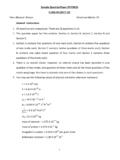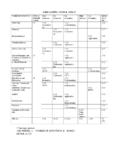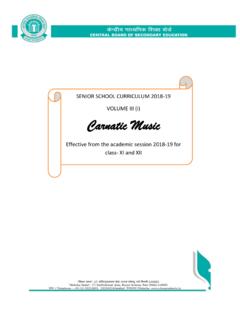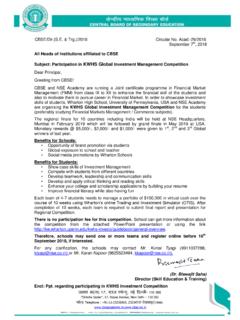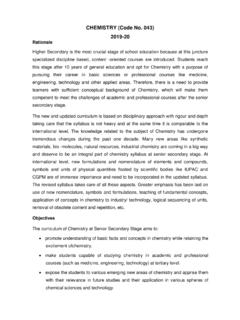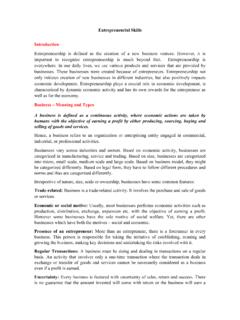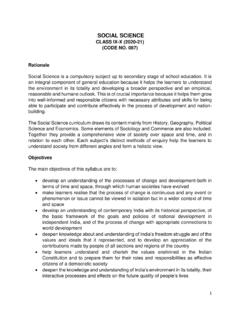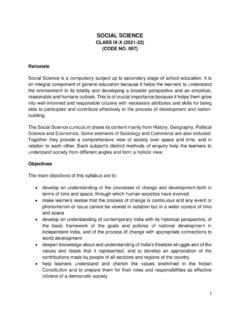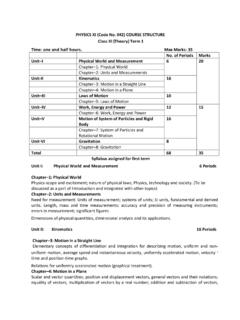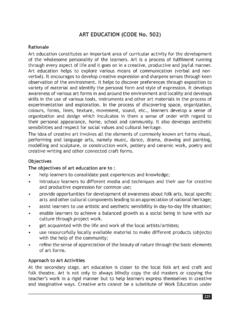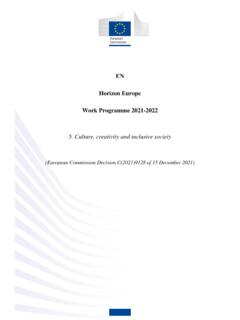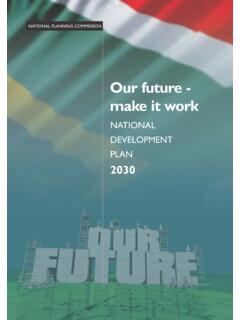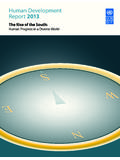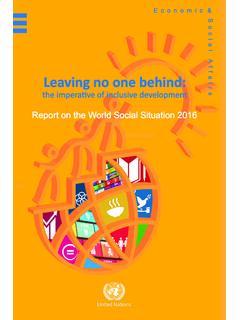Transcription of CLASS IX-X (2021-22) TERM WISE CURRICULUM
1 1 SOCIAL SCIENCE CLASS IX-X (2021-22) CODE NO. (087) TERM WISE CURRICULUM Social Science is a compulsory subject up to secondary stage of school education. It is an integral component of general education because it helps the learners to understand the environment in its totality and developing a broader perspective and an empirical, reasonable and humane outlook. This is of crucial importance because it helps them grow into well-informed and responsible citizens with necessary attributes and skills for being able to participate and contribute effectively in the process of development and nation- building.
2 The Social Science CURRICULUM draws its content mainly from History, Geography, political Science and Economics. Some elements of Sociology and Commerce are also included. Together they provide a comprehensive view of society over space and time, and in relation to each other. Each subject s distinct methods of enquiry help the learners to understand society from different angles and form a holistic view. Objectives The main objectives of this syllabus are to: develop an understanding of the processes of change and development-both in terms of time and space, through which human societies have evolved make learners realise that the process of change is continuous and any event or phenomenon or issue cannot be viewed in isolation but in a wider context of time and space develop an understanding of contemporary India with its historical perspective, of the basic framework of the goals and policies of national development in independent India.
3 And of the process of change with appropriate connections to world development deepen knowledge about and understanding of India s freedom struggle and of the values and ideals that it represented, and to develop an appreciation of the contributions made by people of all sections and regions of the country help learners understand and cherish the values enshrined in the Indian Constitution and to prepare them for their roles and responsibilities as effective citizens of a democratic society deepen the knowledge and understanding of India s environment in its totality, their interactive processes and effects on the future quality of people s lives facilitate the learners to understand and appreciate the diversity in the land and people of the country with its underlying unity develop an appreciation of the richness and variety of India s heritage-both natural and cultural and the need for its preservation 2 promote an understanding of the issues and challenges of contemporary India- environmental, economic and social, as part of the development process help pupils acquire knowledge.
4 Skills and understanding to face the challenges of contemporary society as individuals and groups and learn the art of living a confident and stress-free life as well as participating effectively in the community develop scientific temperament by promoting the spirit of enquiry and following a rational and objective approach in analysing and evaluating data and information as well as views and interpretations develop academic and social skills such as critical thinking, communicating effectively both in visual and verbal forms - cooperating with others, taking initiatives and providing leadership in solving others problems develop qualities clustered around the personal, social, moral, national and spiritual values that make a person humane and socially effective.
5 COURSE STRUCTURE CLASS IX (2021-22) TERM- I M. MARKS: 40 No. Units No. of Periods Marks I India and the Contemporary World -1 17 10 II Contemporary India I 14 10 III Democratic Politics I 20 10 IV Economics 20 10 Total 71 40 TERM- II M. MARKS: 40 No. Units No. of Periods Marks I India and the Contemporary World -1 34 10 II Contemporary India I 24 10 III Democratic Politics I 18 10 IV Economics 10 10 Total 86 40 3 COURSE CONTENT- IX TERM- I Unit 1: India and the Contemporary World I Themes Learning Objectives Section 1: Events and Processes: (Theme one) I.
6 The French Revolution French Society during the late eighteenth century The Outbreak of the Revolution France abolishes Monarchy and Becomes a Republic Did Women have a Revolution? The Abolition of Slavery The Revolution and Everyday Life In this theme students would get familiarized with distinct ideologies, extracts of speeches, political declarations, as well as the politics of caricatures, posters and engravings. Students would learn how to interpret these kinds of historical evidences. Familiarize with the names of people involved, the different types of ideas that inspired the revolution, the wider forces that shaped it.
7 Know the use of written, oral and visual material to recover the history of revolutions. Unit 2: Contemporary India I Themes Learning Objectives 1. India Size and Location India and the World India s Neighbours 2. Physical Features of India Major Physiographic Divisions Identify the location of India in the Indian subcontinent. Understand the major landform features and the underlying geological structure; their association with various rocks and minerals as well as nature of soil types. Unit 3: Democratic Politics I Themes Learning Objectives 1.
8 What is Democracy? Why Democracy? What is Democracy? Features of Democracy Why Democracy? Develop conceptual skills of defining democracy. Understand how different historical processes and forces have promoted democracy. 4 Broader Meaning of Democracy 2. Constitutional Design Why do we need a Constitution? Making of the Indian Constitution Guiding Values of the Indian Constitution Develop a sophisticated defence of democracy against common prejudices. Develop a historical sense of the choice and nature of democracy in India. Understand the process of Constitution making.
9 Develop respect for the Constitution and appreciation for Constitutional values. Recognize Constitution as a dynamic and living document. Unit 4: Economics Themes Learning Objectives 1. The Story of Village Palampur Overview Organization of production Farming in Palampur Non-farm activities of Palampur 2. People as Resource Overview Economic activities by men and women Quality of Population Unemployment Familiarize with basic economic concepts through an imaginary story of a village. Understand the demographic concepts.
10 Understand how population can be an asset or a liability for a nation. 5 LIST OF MAP ITEMS CLASS IX (2021-22) TERM I ---------------------------------------- ---------------------------------------- ------------------- SUBJECT - HISTORY Chapter-1: The French Revolution Outline political Map of France Bordeaux Nantes Paris Marseilles SUBJECT GEOGRAPHY Chapter -1: India-Size and Location India-States with Capitals, Tropic of Cancer, Standard Meridian Chapter -2: Physical Features of India Mountain Ranges: The Karakoram, The Zasker, The Shivalik, The Aravali, The Vindhya, The Satpura, Western & Eastern Ghats Mountain Peaks K2, Kanchan Junga, Anai Mudi Plateau - Deccan Plateau, Chotta Nagpur Plateau, Malwa Plateau Coastal Plains - Konkan, Malabar, Coromandel & Northern Circar 6 COURSE CONTENT - IX TERM II Unit 1: India and the Contemporary World I Themes Learning Objectives Section 1: Events and Processes: (Theme two and three) II.
